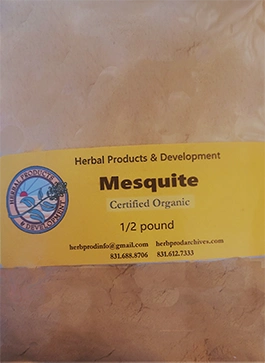The Stabilizer
The mesquite tree is found in the Middle East, India, South Africa, South America (especially in Peru, Argentina, and Brazil), Mexico, and the American Southwest. It is in the family of Leguminosae and is native to deserts, so it is heat and tolerant of drought. Traditional uses included woodworking and charcoal. It has deep roots which can go down as far as 100 feet to gather rich nutrients. The mesquite tree produces naturally sweet, molasses-tasting Bean pods which are milled whole to make a ground meal.
Mesquite is also another traditional food, newly discovered, like quinoa and amaranth. It provides wonderful benefits, including flavor and aroma, to many dishes. As with Copomo (a coffee alternative) in Mexico, cacao worldwide, and many sustainable trees that provide fruit, nuts, and seeds, mesquite is known for its continuous yields that provide both nutrition and a sustainable livelihood. Mesquite stabilizes the land (arroyos, banks, hills) as well as the body.
Mesquite action is cold and dry. Its resin, however, is more warming and tonifying. It is an antifungal, antimicrobial, and antispasmodic. It helps stop excessive bleeding and fevers. It is used in first aid as a paste for stings, scrapes, cuts, and insect bites. Mesquite contains approximately 1/3 soluble fiber and is a slow-acting carbohydrate. It, therefore, helps balance and control blood sugar by its slower, steady rate of absorption into the bloodstream. Diabetes is a decline in glucose tolerance. Mesquite is an antidiabetic natural sweetener (often made into a porridge) which, because it contains fructose, provides effective use of insulin metabolism. Its glycemic index is 25. Its fat content is 3.5%.

Many of the Southwest native peoples who have abandoned mesquite and other traditional foods for a modern diet have had to contend with obesity and diabetes. When returning to a traditional diet, these problems are greatly controlled. Historically, the Southwest desert tradition that used lima beans, chia seeds, prickly pear pods, squash, red and white corn, Anasazi beans, Amaranth, and Pinole (toasted ground cornmeal), all that complement mesquite meal, have provided health and survival benefits and future security to arid lands.
Like dehulled hemp seeds, mesquite is mineral-rich, providing in particular calcium, magnesium, potassium, iron, sulfur, manganese, and other valuable trace minerals. Mesquite is, on average, 14–16% protein. Its high lysine content provides a perfect balance to the high arginine of cacao. Mesquite is a grounding, balancing, and nutritive contribution to the body.
Though being such a drought-resistant tree, mesquite still seeks water. Thus, tightly seal the bag of mesquite meal as it can be hygroscopic (picking up moisture from the air). We return to the desert and its most primal essence—the mesquite tree.
Mesquite and Carob
Carob is also in the Leguminosae family and has the name of locust bean. It has a 5% protein and 7% fiber content and is rich in minerals and B vitamins. Carob meal has a pleasant, rich flavor resembling chocolate and is often used as a chocolate substitute in many food products.
Both mesquite and carob form pods that are a galactomannan-type polysaccharide. They are hammer-milled ground whole to produce a meal. Good as stabilizers, they have thickening and emulsifying properties. They have a higher lysine to arginine ratio which is important in proper amino acid balance for the body.
Both mesquite and carob are used in the paper and print industry, in textiles, pharmaceuticals, cosmetics, detergents, paints, and inks. They slow the melting rate of ice cream and are found in other dairy products including soft cheeses. They are used in baked goods, pie fillings, desserts, and sauces. They provide an excellent nutritional and flavorful balance to live food desserts using cacao nibs.
Mesquite is rich in minerals, protein, soluble fiber, and slow-acting carbohydrates. It is used traditionally in the Southwest of the United States. Mesquite is a natural sweetener and adds flavor and aroma to cuisine. Its slow, steady rate of absorption into the bloodstream helps balance and control blood sugar.
Mesquite provides wonderful benefits, including flavor and aroma, to many dishes. It is an antifungal, antimicrobial, and antispasmodic. It is used in first aid as a paste for stings, scrapes, cuts, and insect bites. It helps stop excessive bleeding and fevers.
Mesquite contains approx. 1/3 soluble fiber, and is a slow-acting carbohydrate. It therefore helps balance and control blood sugar by its slower, steady rate of absorption into the bloodstream. Diabetes is a decline in glucose tolerance. Mesquite is an antidiabetic natural sweetener (often made into a porridge) which, because it contains fructose, provides effective use of insulin metabolism, plus it is high in fiber. Its glycemic index is 25. Its fat content is at 3-1/2%.
Mesquite is mineral-rich, including calcium, magnesium, potassium, iron, sulfur, manganese, and other valuable trace minerals. Mesquite averages 14-–6% protein. it is a grounding, balancing, and nutritive contribution to the body.
Size: 1-pound heat-sealed bags
